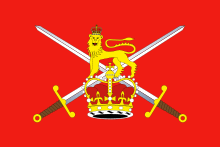14 Intelligence Company
| British Army |
|---|
 |
| Components |
| Administration |
| Overseas |
| Personnel |
|
| Equipment |
| History |
| British Army portal |
14 Field Security and Intelligence Company (also known as "The Det", but most commonly "Int & Squint") was a part of the British Army Intelligence Corps which operated in Northern Ireland from the 1970s onwards. The unit conducted undercover surveillance operations against suspected members of Irish republican and loyalist paramilitary groups. Many allegations of collusion with loyalist paramilitaries were made against the unit.
Predecessors
The 14 Intelligence Company was the successor to the Special Reconnaissance Unit (SRU), which was itself a reconstituted Military Reaction Force (MRF).[1] "Special Reconnaissance Unit" is the term appearing in official documents from the 1970s. An April 1974 briefing for Prime Minister Harold Wilson states:
- The term "Special Reconnaissance Unit" and the details of its organisation and mode of operations have been kept secret. The SRU operates in Northern Ireland at present under the cover name "Northern Ireland Training and Advisory Teams (Northern Ireland)" - NITAT(NI) - ostensibly the equivalent of genuine NITAT teams in UKLF (UK Land Forces) and BAOR (British Army of the Rhine).[2]
Structure
Authors claiming to be former members of the unit describe an organisation[3][4][5][6][7] with a depot in Great Britain and four operational detachments in Northern Ireland.
- Main Det (Headquarters), RAF Aldergrove.
- East Det, based at Palace Barracks, Belfast.
- North Det, based at Ballykelly County Londonderry.
- South Det based at Fermanagh.
Selection and training of personnel from all arms of the British Armed Forces was conducted in a number of locations on the mainland. Candidates, both male and female, volunteered for special duties for periods of 18–36 months, before being returned to a parent unit. Trained surveillance operators could volunteer for re-deployment after a period with the parent unit, with potential opportunities to serve in command, staff or training roles within the organisation or higher command structure.
Collusion accusations
14 Intelligence was accused of acting in collusion with loyalist paramilitaries by former intelligence personnel Fred Holroyd and Colin Wallace in regards to the death of senior Provisional Irish Republican Army member John Francis Green, the Miami Showband killings and the Dublin and Monaghan Bombings.[8][9][10][11][12]
Casualties
- 14 April 1974: Captain Anthony Pollen was shot dead in Derry City while carrying out undercover surveillance on a Sinn Féin event. He was shot twice in front of a crowd of more than 150 people.
- 15 May 1977: Captain Robert Nairac kidnapped and shot by the IRA.
- 14 December 1977: Corporal Paul Harman was shot dead by the IRA in west Belfast. Harman was undercover when he stopped his red Morris Marina on Monagh Avenue. An IRA unit approached the car and shot him in the head and back and torched the car.
- 11 August 1978: 14th Intelligence operative Lance Corporal Alan Swift was shot dead while undercover in the Bogside area of Derry City. Two IRA members fired into the corporal's car with automatic rifles.
- 21 February 1984: Paul Oram was killed in a gun battle between the IRA and up to ten undercover British soldiers. A three-man IRA unit was ambushed by soldiers in Dunloy killing Henry Hogan and Declan Martin. The third member escaped. Oram was killed in the battle and another soldier was seriously wounded.
See also
References
- ↑ Griffin, Tom (20 November 2013). "The long shadow of the Military Reaction Force". Spinwatch.org. Retrieved 15 April 2015.
- ↑ "PREM 16/154: Defensive Brief D - Meeting between the Prime Minister and the Taoiseach, 5 April 1974 "Army Plain Clothes Patrols in Northern Ireland"" (PDF). The National Archives. London. Retrieved 15 April 2015.
- ↑ Rennie, James (2004). The Operators: On the Streets with Britain's Most Secret Service. Barnsley: Pen & Sword Military Classics. ISBN 9781844150991.
- ↑ Ford, Sarah (1997). One Up: A woman in action with the SAS. London: HarperCollins. ISBN 9780002558198.
- ↑ George, Jackie (1999). She Who Dared: Covert Operations in Northern Ireland with the SAS. Barnsley: Leo Cooper. ISBN 9780850526868.
- ↑ Falconer, Duncan (2001). First into Action: Dramatic Personal Account of Life Inside the SBS. London: Warner. ISBN 9780751531657.
- ↑ Connor, Ken (1999). Ghost Force: Secret History of the SAS. London: Orion. ISBN 9780752826974.
- ↑ Friel, Laura (6 January 2000). "The killing of John Francis Green". An Phoblacht. Retrieved 15 April 2015.
- ↑ McCaffrey, Barry (13 July 2006). "Revealed — how British threatened harsh sanctions over SAS arrests". Irish News. Retrieved 15 April 2015.
- ↑ Ken Livingstone, Member for Brent East (7 July 1987). "Northern Ireland Act 1974". Parliamentary Debates (Hansard). House of Commons. col. 231–237.
- ↑ "Interim Report on the Report of the Independent Commission of Inquiry into the Bombing of Kay's Tavern, Dundalk". Houses of the Oireachtas: Joint Committee on Justice, Equality, Defence and Women's Rights. July 2006. Retrieved 15 April 2015.
- ↑ Holroyd, Fred (1989). War Without Honour. Hull: Medium. ISBN 9781872398006.
External links
- "Brits Programme 3 - Holding The Line - Transcript". BBC News (London: BBC). 2000. Retrieved 15 April 2015.
- "Special Forces - Roll Of Honour". 2015. Retrieved 15 April 2015.